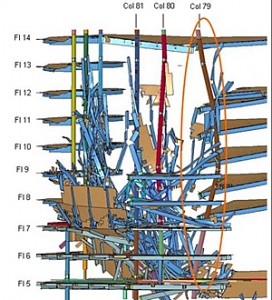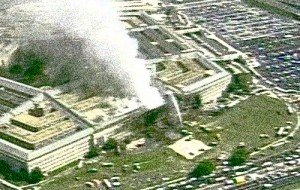Two Days Before 9/11, Military Exercise Simulated Suicide Hijack Targeting New York
by Kevin Fenton
historycommons.org
The US military conducted a training exercise in the five days before the September 11 attacks that included simulated aircraft hijackings by terrorists, according to a 9/11 Commission document recently found in the US National Archives. In one of the scenarios, implemented on September 9, terrorists hijacked a London to New York flight, planning to blow it up with explosives over New York.
 The undated document, entitled “NORAD EXERCISES Hijack Summary,” was part of a series of 9/11 Commission records moved to the National Archives at the start of the year. It was found there and posted to the History Commons site at Scribd by History Commons contributor paxvector in the files of the commission’s Team 8, which focused on the failed emergency response on the day of the attacks. The summary appears to have been drafted by one of the commission’s staffers, possibly Miles Kara, based on documents submitted by NORAD.
The undated document, entitled “NORAD EXERCISES Hijack Summary,” was part of a series of 9/11 Commission records moved to the National Archives at the start of the year. It was found there and posted to the History Commons site at Scribd by History Commons contributor paxvector in the files of the commission’s Team 8, which focused on the failed emergency response on the day of the attacks. The summary appears to have been drafted by one of the commission’s staffers, possibly Miles Kara, based on documents submitted by NORAD.
In the September 9 scenario, the fictitious terrorists’ goal seems to have been to kill New Yorkers with the rain of debris following the plane’s explosion. However, in the exercise, the military intercepted the plane and forced it away from the city. When the terrorists realized they were not near New York, they blew the plane up “over land near the divert location,” leaving no survivors. The military unit most involved in this scenario was NORAD’s Northeast Air Defense Sector (NEADS), which also played a key role in the air defense response to the 9/11 attacks, two days later.
Numerous Hijacks Listed
Three days earlier, on September 6, NORAD simulated two hijackings as part of the same exercise, which was called “Vigilant Guardian.” In one scenario, a fictitious terrorist organization called Mum Hykro hijacked a Boeing 747 from Tokyo to the US and made a “threat of harm to passengers and possibly large population within US or Canada.” The terrorists intended to “rain terror from the skies onto a major US city unless the US declares withdrawal from Asian conflict.” The plane is listed as being bound for Anchorage, Alaska, although the hijackers changed course for Vancouver in Canada, and then for San Francisco, California. Liaising with the FAA, NORAD provided “covert shadowing” of the hijacked plane.
In a second hijack scenario on the same day, ten members of another fictitious terrorist group, called Lin Po, hijacked another 747 to Anchorage, this time out of Seoul, South Korea. The hijackers were armed, their weapons having been smuggled onto the plane by ground crews before takeoff. They also had gas containers that could be detonated. Two of the plane’s passengers were killed, and the CIA and NSA warned that the group had the means to pull off an attack with chemical and biological weapons. In response, NORAD’s commander in chief ordered fighters from the Alaskan NORAD Region (ANR) to intercept and shadow the hijacked plane, and get into “position to shoot down aircraft.”
Another scenario included in the Vigilant Guardian exercise was run the day before 9/11, although this followed the more traditional scenario of Cubans hijacking a flight from Havana and demanding to be taken to New York for political asylum in the US. This scenario involved the participation of NORAD’s Southeast Air Defense Sector (SEADS), and the plane eventually landed at Dobbins Air Force Base in Georgia.
The document lists hijack exercises going back to 1998 several of which had involved internal flights, originating in the US. For example, a January 1999 exercise included the simulated takeover of a Miami to Oklahoma City flight and the hijacking of a San Diego to Anchorage flight the next day.
At the release of the 9/11 Commission Report in July 2004, the panel’s chairman Tom Kean famously said that the main reason the 9/11 attacks were not prevented was that there had been a “failure of imagination.” However, the hijack simulation planners were really quite imaginative and in several of the scenarios the hijackers had WMD actually on board the aircraft. For example, in a September 1999 exercise, hijackers on a 747 bound from Hong Kong to Canada had sarin gas on board, and threatened to blow up the plane. An exercise the following month included the simulation of a terrorist group hijacking a plane with American and Canadian citizens on board. The plane was bound from France to Canada, and the terrorist group was said to have the “will and means to strike North America with WMD.” Communications with the plane were lost following the hijacking, but the crew overpowered the terrorists and regained control of the plane at the last second.
An exercise in October 1998 included terrorists hijacking a 747 with the intent of committing a “suicide run into [a] metropolitan area of” San Francisco. And an October 2000 exercise included the simulated hijacking of a plane bound from London to Cairo. The scenario was that “100 religious fanatics will take over the aircraft,” but the “aircraft will land at JFK [airport in New York] without incident and [the] FBI will escort [the] hijackers.”
Perhaps the most imaginative scenario, part of a June 2001 exercise, had a Colombian drug cartel cartel making a deal with a Haitian AIDS victim to carry out a suicide attack with a private aircraft against a SEADS command and control node. Alerted by the FBI, the military had to “work to keep aircraft from impacting SEADS.” The document ominously states that the “scenario fruition” was “up to Blue Forces,” meaning the group playing the US defenders in the exercise.
Hijacking Exercise on Day of 9/11
Although it is not listed in the document, there was also a simulated plane hijacking scheduled to take place in the Northeast US on the day of 9/11, and its timing overlapped with the real-world events. According to Vanity Fair, “The day’s exercise was designed to run a range of scenarios, including a ‘traditional’ simulated hijack in which politically motivated perpetrators commandeer an aircraft, land on a Cuba-like island, and seek asylum.”
When NEADS was informed of the first real-world hijacking, members of its staff initially assumed this was part of the exercise. For example, Master Sergeant Maureen Dooley, the leader of the ID section, told the other members of her team: “We have a hijack going on. Get your checklists. The exercise is on.” Major Kevin Nasypany, the mission crew commander, actually said out loud, “The hijack’s not supposed to be for another hour.” Like the numerous hijacking scenarios described in the “NORAD EXERCISES” document, there was no mention of this simulated hijacking scheduled for the morning of September 11 in the 9/11 Commission Report.
Clearly, further investigation is required to verify the extraordinary details revealed in the “NORAD EXERCISES” document, and in particular find out what else the September 2001 Vigilant Guardian exercise involved. The fact that this exercise included simulations of terrorists hijacking aircraft, and that New York City was central to some of its scenarios, should be a major concern.
Originally posted here with excerpts from the document.
NORAD EXERCISES Hijack Summary document found here.


























